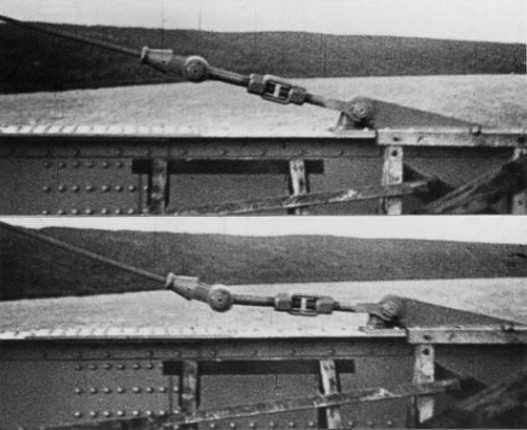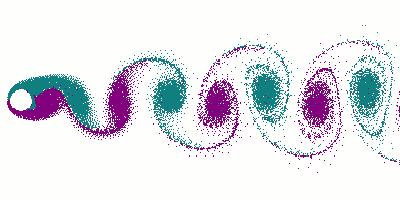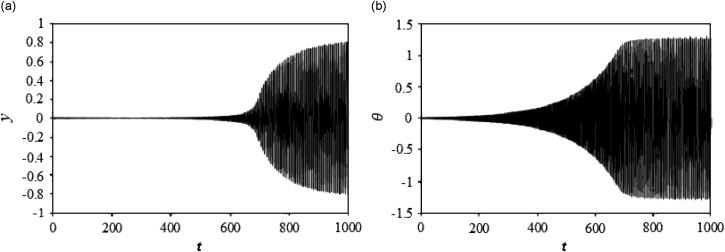The Start of the Torsional Oscillations
The start of the torsional oscillations was due to the
loosening of a cable band on the northern end of the
mid-span of the bridge. Prior to the cable loosening,
the hanger ties on the bridge were alternating between being
slack and taut due to the oscillations already occuring on
the bridge. This was causing snap loads to be put on
the cable that it was not designed to handle, which caused
it to fail by fraying and loosening and led to the start of
the torsional oscillations. Now, normally suspension
bridges undergo very limited torsional movement; however,
when symmetry around the bridge's center line is lost, which
is what happened to the Tacoma Narrows Bridge, then
torsional oscillations are expected to initiate, and, if
circumstances allow, increase in magnitude.
Cables on the bridge alternating between being slack and taut.
Taken from: http://www.sciencedirect.com/science/article/pii/S0022460X07005792
Vortex Shedding and Resonance
This theory was originally put forth by the lead engineer
who investigated the collapse on commission of the DOT
(Department of Transportation), he outlined this theory in
his autobiography in which he stated that this was the
reason for the collapse. This however completely
contradicted his original report which explicitly stated
that it was not vortex shedding that caused the collapse of
the bridge. This has become the popular theory among
the general public and has been used as a classic example of
the extreme results that resonance can produce. 
Standard example of simple vortex shedding.
Taken from: http://en.wikipedia.org/wiki/Tacoma_Narrows_Bridge_%281940%29#mediaviewer/File:Vortex-street-animation.gif
Aeroelastic Flutter and Negative Damping
The alternative model of the bridge's collapse is based on aeroelastic flutter, causing a negative damping situation to occur in the bridge. This theory also has changed the model to a non-linear equation, and much better reflected the bridge's behavior before, and during, its collapse. Their inherent unpredictability matched up well with the fact that at time smaller wind speeds would produce larger magnitude oscillations in the bridge than higher wind speeds would.In aeroelastic flutter, the wind would blow on the side of the bridge and cause a clockwise or counterclockwise torque to act on the bridge, depending on the section's current orientation. This torque acts on the bridge in such a way that it is always amplifying the current motion of that section of the bridge and causing the magnitudes of the oscillations to increase in size. The force caused by the aeroelastic flutter in this model causes a situation to occur known as negative damping.

Vertical (a) and Torsional (b) movement of the bridge modeled by a nonlinear negative damping coefficient.
Taken from: http://www.sciencedirect.com/science/article/pii/S0022460X07005780
Negative damping refers to a situation in harmonic equations in which the damping coefficient is negative. This causes the magnitude of the oscillations to increase over time instead of the typical situation where the magnitude decreases. Negative damping actually occurs in many real life situations, most notably: in a number of musical instruments.
This model actually correlates very well with the initial cause of the torsional oscillations when the cable band started to fail. When this occurred, the bridge started to twist, and this was amplified by the torque that would have been applied by the wind and led to the start of the negative damping which caused the bridge to fail.